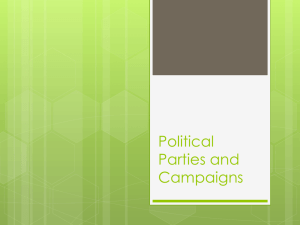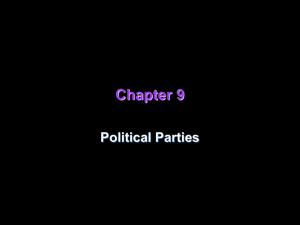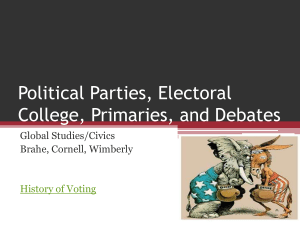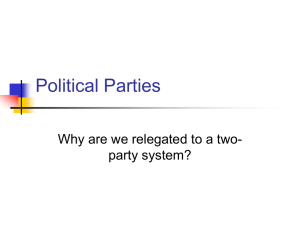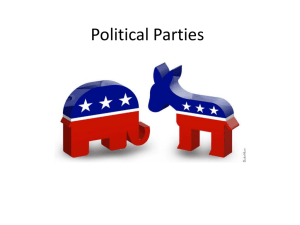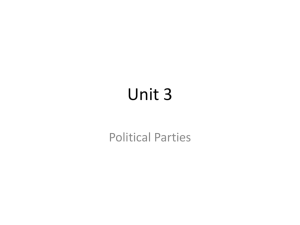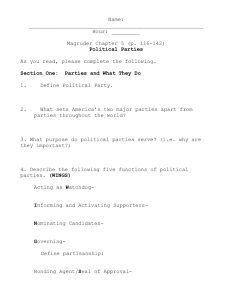Chapter 9 Notes - Plain Local Schools
advertisement
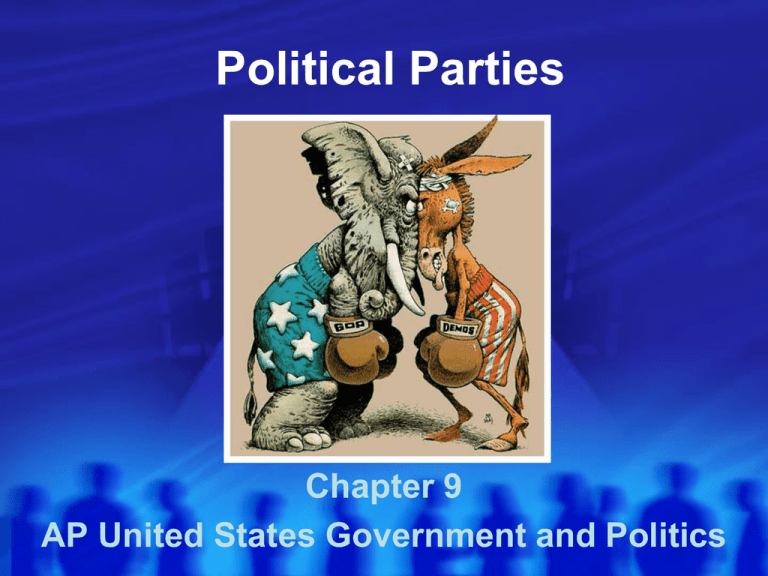
Political Parties Chapter 9 AP United States Government and Politics Parties – Here and Abroad A. Decentralization 1. 2. A party is a group that seeks to elect candidates to public office by supplying them with a label (party identification), by which they are known to the electorate Arenas of politics in which parties exist: a) b) c) 3. Label, in the minds of the voters Organization, recruiting and campaigning for candidates Set of leaders, organize and try to control the legislative and executive branches United States parties have become weaker in all three arenas a) b) c) As label, because there are more independents and more split-ticket voting As set of leaders, though, parties are still somewhat strong As organization, parties have become weaker since 1960s Parties – Here and Abroad B. Reasons United States and European parties are different 1. 2. European parties are disciplined gatekeepers, to which voters are very loyal, though this has been declining recently Federal system decentralizes power in U.S. a) b) c) 3. 4. 5. Early on, the most important government decisions were made by the state and local governments, and this is where most of the political jobs were National parties were then coalitions of local parties As political power became more centralized, parties became even more decentralized and weaker Parties closely regulated by state and federal laws, which weaken them Candidates are now chosen through primaries, not by party leaders President elected separately from Congress and presidential appointees are drawn from many sources Parties – Here and Abroad C. Political culture 1. Parties are relatively unimportant in life; Americans do not join or pay dues to a political party 2. Political parties are separate from other aspects of life The Rise and Decline of the Political Party A. The Founding (to 1820s) 1. 2. 3. Founders disliked parties, viewing them as factions For parties to be acceptable, people had to be able to distinguish between policy disputes and challenges to the legitimacy of government Emergence of Republicans, Federalists: Jefferson vs. Hamilton a) b) c) 4. Loose caucuses of political notables Republicans’ success (Jefferson, Madison, Monroe) and Federalists’ demise Reflection of the newness of parties is seen in the weakness of this system No representation of homogeneous economic interests – parties were always heterogeneous coalitions The Rise and Decline of the Political Party B. The Jacksonians (to Civil War) 1. Political participation became a mass phenomenon a) More voters to be reached – by 1832, presidential electors selected by popular vote in most states b) Party built from bottom, up c) Abandonment of presidential caucuses composed of Congressional members d) Beginning of national party conventions, allowing local control The Rise and Decline of the Political Party C. The Civil War and Sectionalism (to 1930s) 1. 2. Jacksonian system unable to survive slavery and sectionalism New Republicans became dominant because of… a) b) 3. Civil War – Republicans relied on Union pride Bryan’s alienation of northern Democrats in 1896, deepening sectionalism Most states were dominated by one party a) b) c) Factions emerged within each party Republicans broke into professional politicians (Old Guard) and progressives (mugwumps) Progressives initially shifted between parties to gain power, but then began attacking partisanship when the Republicans became dominant The Rise and Decline of the Political Party D. The Era of Reform (beginning in the 1900s, but chiefly since the New Deal) 1. Progressives pushed measures to curtail parties’ power and influence a) b) c) d) e) f) 2. Primary elections favored, to replace nominating conventions Nonpartisan elections at city and (sometimes) state level No party-business alliances, on the grounds that they were corrupting Strict voter registration requirements in order to reduce fraud Civil service reform in order to eliminate patronage Initiative and referendum so that citizens could vote directly on proposed legislation Effects a) b) Reduced the worst forms of political corruption Weakened all political parties – parties became less able to hold officeholders accountable or to coordinate across the branches of government The Rise and Decline of the Political Party E. Party Realignments 1. Critical or realigning periods: periods when a sharp, lasting shift occurs in the popular coalition supporting one or both parties a) b) 2. Five realignments so far a) b) c) d) e) 3. Issues that separate the parties change, so the kinds of voters supporting each party change Shift may occur at the time of the election or just after 1800 (Jeffersonian Republicans defeated Federalists) 1828 (Jacksonian Democrats came to power) 1860 (Whig party collapsed; Republicans came to power) 1896 (Republicans defeated William Jennings Bryan) 1932 (Democrats came to office under FDR) Two kinds of realignments a) b) A major party is defeated so badly that it disappears and a new party emerges Two existing parties continue but voters shift their loyalty from one to another The Rise and Decline of the Political Party E. Party Realignments (continued) 4. Clearest cases of realignment: 1860, 1896, 1932 a) b) c) 5. 1980: a new realignment? a) b) 6. 1860: slavery issue fixed new loyalties in the popular mind 1896: economic issues shifted loyalties to East vs. West, city vs. farm split 1932: economic depression triggered new coalition for Democrats Reagan won in 1980 because he was not Jimmy Carter Could not have been a traditional realignment because Congress was left in the hands of the Democrats Major shift that has occurred: shift in presidential voting patterns in the South a) b) 1972-2004: South had been more Republican than nation as a whole If continues, will constitute a major regional realignment The Rise and Decline of the Political Party F. Party decline 1. 2. 3. Evidence that parties are declining, not realigning Proportion of people identifying with a party declined between 1960 and 1980 Proportion of those voting a split ticket increased Was almost unheard of in the 19th century, because voters were given ballots by the parties b) Became more common with the adoption of the officebloc ballot (listing candidates by office instead of party) a) The National Party Structure Today A. Parties similar on paper 1. National convention has ultimate power; meets every four years to nominate the presidential candidate 2. National committee is composed of delegates from states; manages affairs between conventions 3. Congressional campaign committees support the party’s congressional candidates 4. National chair manages daily work The National Party Structure Today B. Party structure diverged in late 1960s and early 1970s 1. RNC moved to bureaucratic structure a) b) c) d) 2. Democrats moved to factionalized structure and redistributed power a) b) 3. Became a well-financed party devoted to electing its candidates, especially to Congress Beginning in 1980s, RNC used computerized mailing lists to raise money Money was used to provide services to candidates RNC effectively created a national firm of political consultants Democrats lost 5 out of 6 presidential elections between 1968 and 1988 By the 1990s, DNC had learned from the RNC: adopted the same techniques, with some success DNC and RNC send money to state parties, to sidestep federal spending limits (soft money) The National Party Structure Today C. National Conventions 1. 2. National committee sets time and place; issues a “call” setting the number of delegates for each state and the rules for their selection Formulas are used to allocate delegates a) b) c) 3. 4. Democrats’ formula shifts delegates away from the South, to the North and West Republicans’ formula shifts delegates away from the East, to the South and Southwest Result: Democrats move left, Republicans right Democrat formula rewards large states while the Republican formula rewards loyal states Democrats set new rules a) b) In 1970s, rules were changed to weaken local party leaders and increase the proportions of women, youth, Blacks, and Native Americans attending the convention Hunt Commission in 1981 increased the influence of elected officials and made the convention more deliberative http://www.cbsnews.com/video/watch/?id=3811304n The National Party Structure Today C. National Conventions (continued) 5. Consequence of reforms: parties represent different sets of uppermiddle-class voters a) b) 6. To become more competitive, Democrats adopted additional rule changes: a) b) 7. Republicans represent traditional middle class – more conservative Democrats represent more leftist wing of the liberal middle class In 1988, the number of superdelegates was increased while the status of some special interest caucuses was decreased In 1992, three rules were set: 1) Winner-reward system of delegate distribution banned – this had previously given the winner of primaries and caucuses extra delegates 2) Proportional representation implemented 3) States that violated the rules were penalized with the loss of convention delegates Conventions today only ratify choices made in primary season United States Parties: Broad Coalitions A. State-level Structure 1. State central committee 2. County committees 3. Various local committees 4. Distribution of power varies with the state, as different incentives are at work United States Parties: Broad Coalitions B. The Machine 1. 2. 3. Definition: a party organization that recruits members via tangible incentives (money, jobs, political favors) High degree of leadership control over member activity Abuses were extensive a) b) 4. 5. Gradually controlled by reforms – voter registration, civil service, Hatch Act (1939) Machines continued until voter demographics and federal programs changed, decreasing the need for the parties’ resources Machines were both self-serving and public-regarding New machine: uses money to knit together many politicians, though money comes from campaign contributions, not from patronage and contracts a) b) New machines are a blend of the old machine (regarding campaign finance) and today’s ideological party traits (regarding issues) Example: Waxman-Berman organization in west Los Angeles United States Parties: Broad Coalitions C. Ideological Parties – extreme opposite to machine 1. 2. 3. 4. Principle is more important than winning election, so ideological parties are contentious and factionalized Usually outside Democratic and Republican parties – “third parties” Currently are generally focused social movements, which advance specific demands Political machine was once the “farm club” of the national party, but today’s social movements perform that function a) b) Factionalism is therefore more intense Party leaders have less freedom United States Parties: Broad Coalitions D. Solidary Groups 1. Members are motivated by solidary incentives (enjoying the game; companionship) 2. Advantage: neither corrupt nor inflexible 3. Disadvantage: not very hard working United States Parties: Broad Coalitions E. Sponsored Parties 1. Created or sustained by another organization 2. Example: Detroit Democrats were developed and led by the United Auto Workers (UAW) union 3. Not very common in U.S. F. Personal Following 1. 2. Requires an appealing personality, an extensive network, name recognition, and money Examples: Kennedys (MA), Talmadges (GA), Longs (LA), Byrds (VA) The Two-Party System A. Rarity among nations today B. Evenly balanced nationally, but not locally C. Why has the two-party system endured for so long? 1. 2. 3. Electoral system – winner-take-all and plurality system limit the number of parties Opinions of voters – two broad coalitions work, although there may be times of bitter dissent State laws have made it very difficult for third parties to get on the ballot Minor Parties: “Third Parties” A. Ideological parties – comprehensive, radical view; most enduring Examples: Socialist, Communist, Libertarian B. One-issue parties – address one concern, avoid others Examples: Free Soil, Know-Nothing, Prohibition C. Economic protest parties – regional, protest economic conditions Examples: Greenback, Populist Minor Parties: “Third Parties” D. Factional parties – from split in a major party, usually over the party’s presidential nominee Examples: Bull Moose, Henry Wallace, American Independent Party E. Surprising that more social movements (e.g., the civil rights movement, anti-war movement) have not produced their own parties 1. 2. There is only a slim chance that they will be successful The major parties accommodate the movements via direct primaries and national party convention Minor Parties: “Third Parties” F. Impact of minor parties on American politics hard to judge 1. Conventional wisdom holds that minor parties develop ideas that the major parties adopt 2. Factional parties have had probably the greatest influence on public policy Nominating a President A. Two Contrary Forces 1. Party’s desire to win the presidency motivates it to seek an appealing candidate 2. Desire to keep dissidents in party forces a compromise with more extreme views Nominating a President B. Are the Delegates Representative of the Voters? 1. Democratic delegates much more liberal 2. Republican delegates much more conservative 3. Outcome cannot be attributed to quota rules for delegate selection, alone – women, youth, minorities have greater diversity of opinions than do the delegates Nominating a President C. Who Votes in Primaries? 1. Primaries now more numerous and more decisive Stevenson (1952) and Humphrey (1968) won the presidential nomination without entering any primaries b) By 1992: forty primaries and twenty caucuses (some states with both) a) 2. 3. Yet studies find little ideological difference between primary voters and rank-and-file party voters Caucus: meeting of party followers at which delegates are picked a) b) Only the most dedicated partisans attend Often choose most ideological candidate: Jackson, Robertson in 1988 Nominating a President D. Who Are the New Delegates? 1. Today’s delegates are issue-oriented activists 2. Advantages of this new system: Increased opportunities for activists within the two major parties b) Decreased probability of their bolting the major parties a) 3. Disadvantage: these delegates may nominate presidential candidates unacceptable to voters or even to the party’s rank and file Parties Versus Voters A. Democrats: since 1968, have more congressional elections but had little success in presidential contests 1. Presidential candidates are out of step with average voters on social and taxation issues 2. So are Democratic delegates to the nominating convention, and there’s a connection between the delegates’ and the candidate’s positions Parties Versus Voters B. Republicans had same problem with Goldwater (1964) C. Rank-and-file Democrats and Republicans differ on many political issues, but the differences are usually small 1. 2. 3. Delegates from the two major parties differ widely on these same issues So, the candidate needs to share views with the average citizen or campaign on issues where delegates and voters agree Problems arise, though, because candidates must often play to the ideological extremes to win delegate support
